A Research Proposal on Inhaler Technique for Asthma Management
VerifiedAdded on 2023/06/14
|14
|3438
|139
Report
AI Summary
This research proposal investigates the effectiveness of correct inhaler techniques in improving asthma control among children aged 4-11 years. It addresses the problem that many patients lack the knowledge and skills for proper inhaler use, leading to suboptimal asthma management. The study aims to determine if teaching correct inhaler techniques can improve asthma control, using a quantitative approach involving an asthma control test questionnaire administered before and after an educational intervention. The protocol includes training sessions for healthcare staff, patient follow-ups, and data analysis using SPSS to compare asthma control scores. Ethical considerations, such as informed consent and data protection, are emphasized. The expected outcome is to demonstrate the significance of proper inhaler technique in asthma management, potentially reducing hospital admissions and improving patients' quality of life.
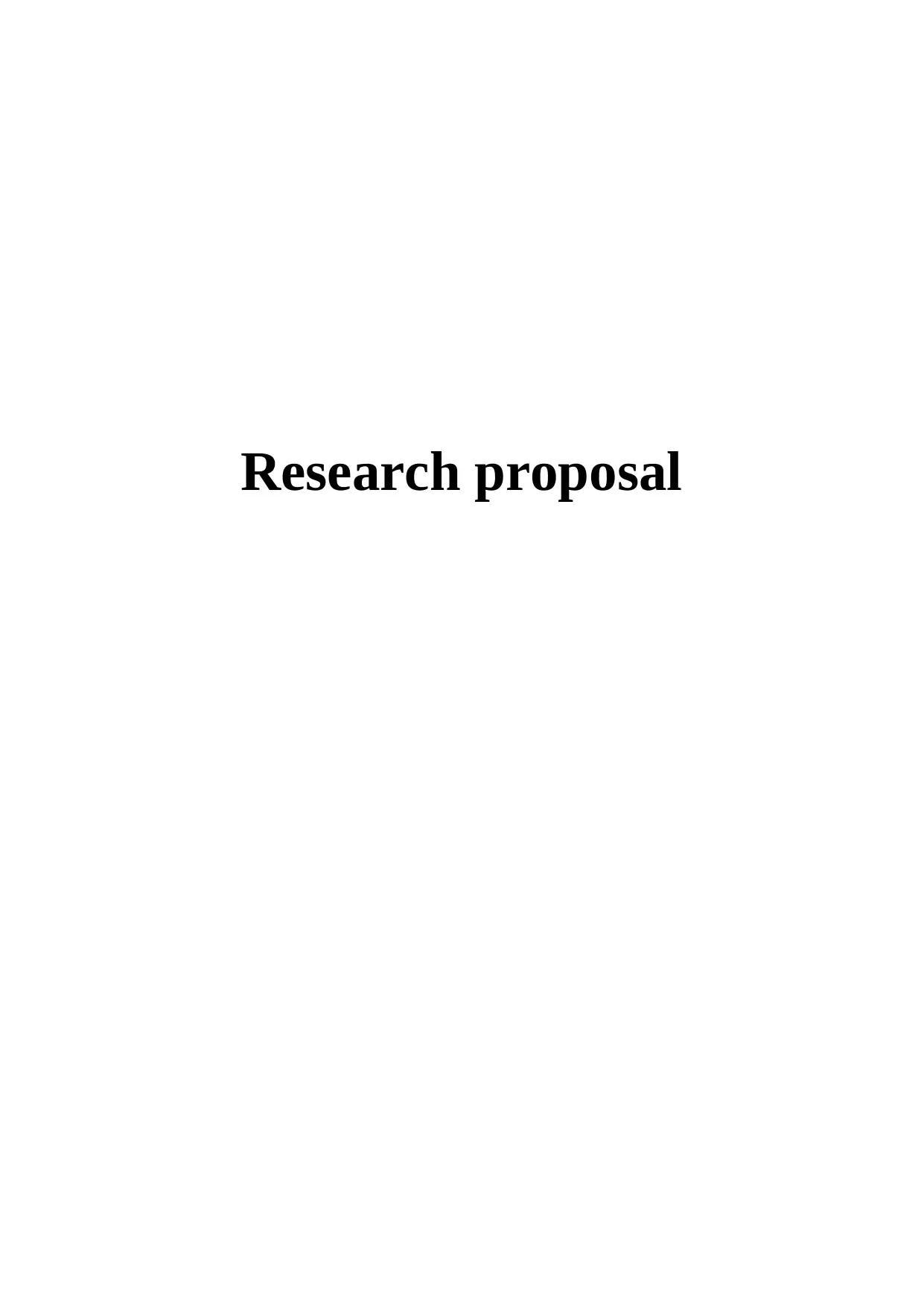
Research proposal
Secure Best Marks with AI Grader
Need help grading? Try our AI Grader for instant feedback on your assignments.
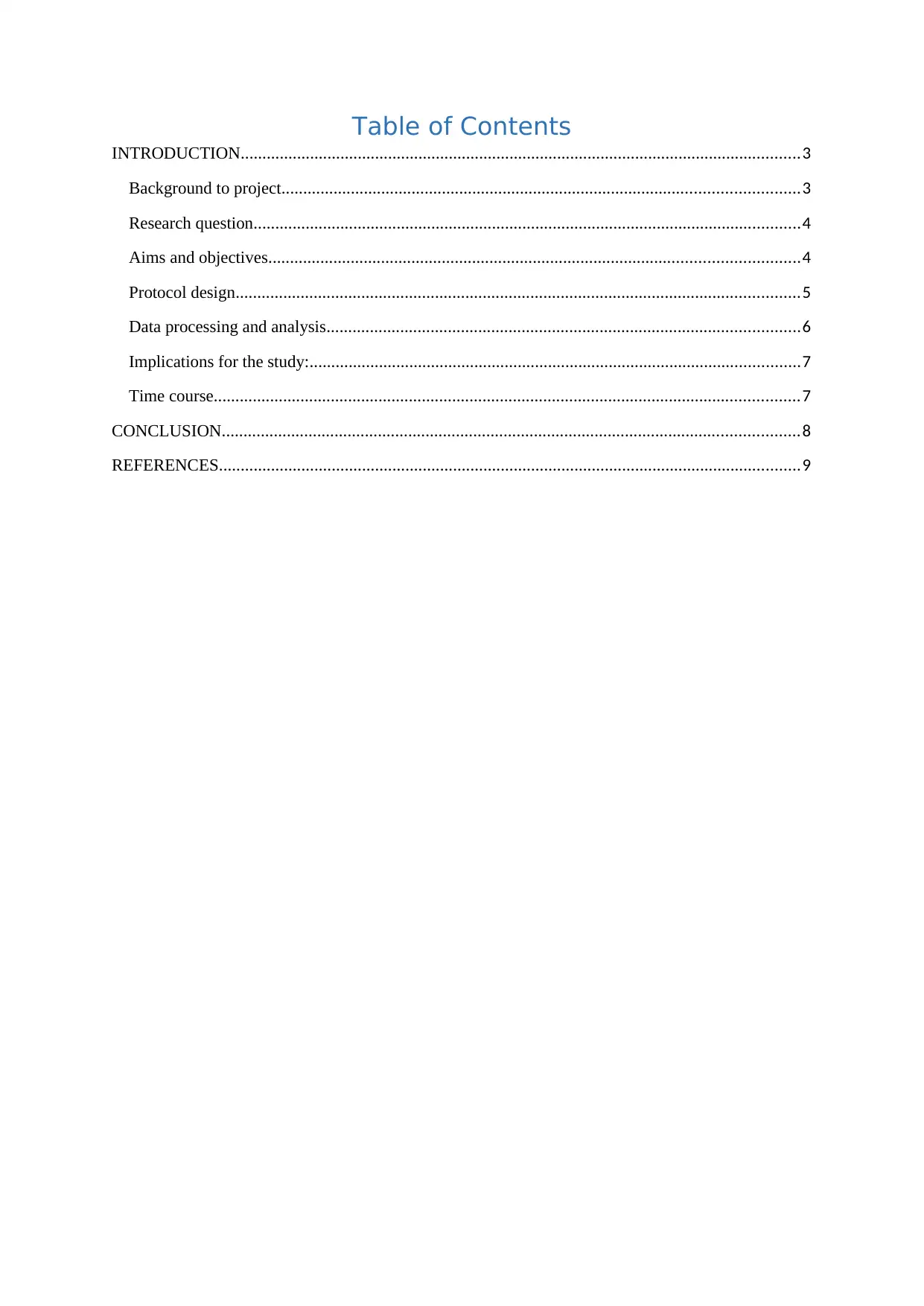
Table of Contents
INTRODUCTION.................................................................................................................................3
Background to project.......................................................................................................................3
Research question..............................................................................................................................4
Aims and objectives..........................................................................................................................4
Protocol design..................................................................................................................................5
Data processing and analysis.............................................................................................................6
Implications for the study:.................................................................................................................7
Time course.......................................................................................................................................7
CONCLUSION.....................................................................................................................................8
REFERENCES......................................................................................................................................9
INTRODUCTION.................................................................................................................................3
Background to project.......................................................................................................................3
Research question..............................................................................................................................4
Aims and objectives..........................................................................................................................4
Protocol design..................................................................................................................................5
Data processing and analysis.............................................................................................................6
Implications for the study:.................................................................................................................7
Time course.......................................................................................................................................7
CONCLUSION.....................................................................................................................................8
REFERENCES......................................................................................................................................9
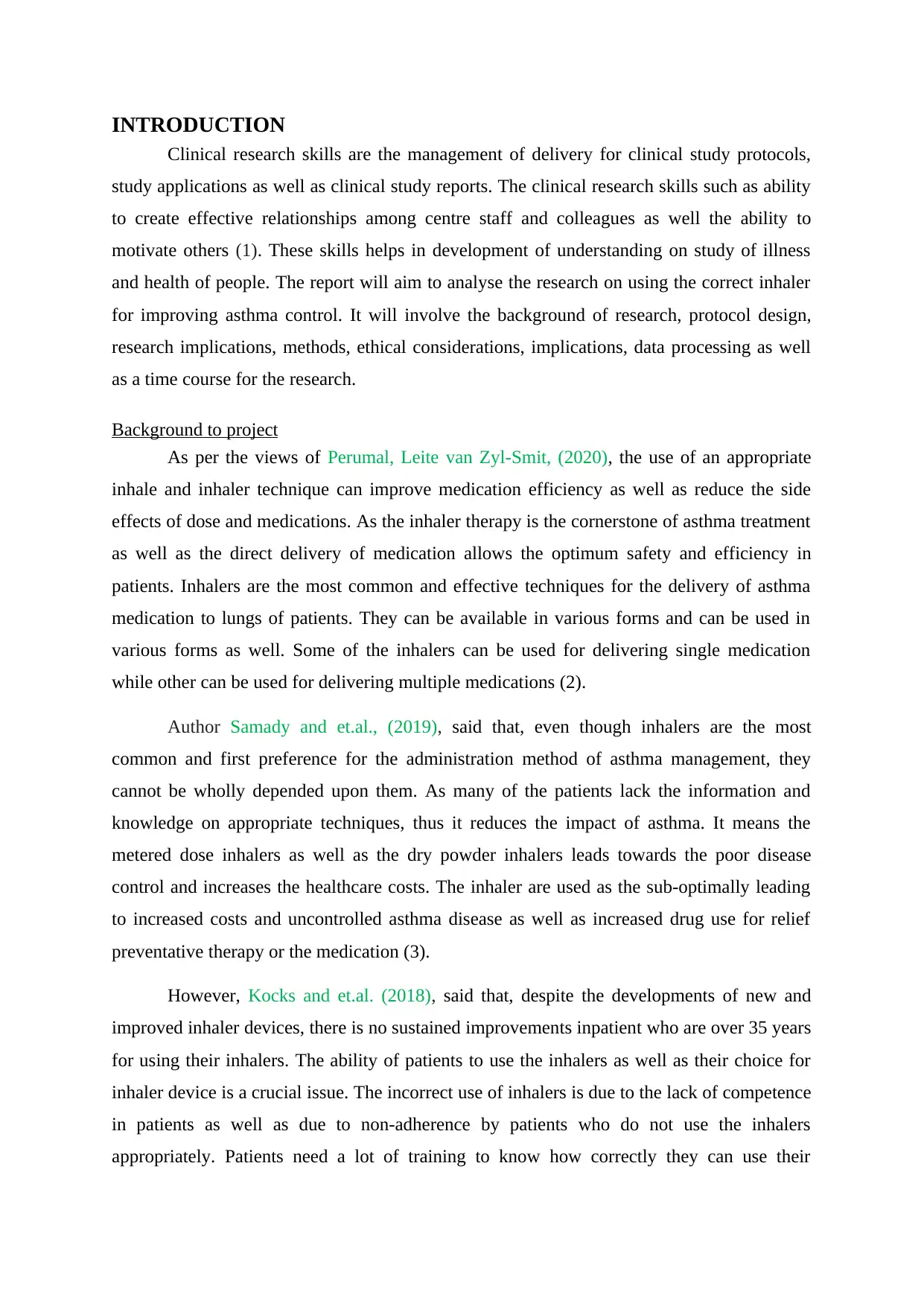
INTRODUCTION
Clinical research skills are the management of delivery for clinical study protocols,
study applications as well as clinical study reports. The clinical research skills such as ability
to create effective relationships among centre staff and colleagues as well the ability to
motivate others (1). These skills helps in development of understanding on study of illness
and health of people. The report will aim to analyse the research on using the correct inhaler
for improving asthma control. It will involve the background of research, protocol design,
research implications, methods, ethical considerations, implications, data processing as well
as a time course for the research.
Background to project
As per the views of Perumal, Leite van Zyl-Smit, (2020), the use of an appropriate
inhale and inhaler technique can improve medication efficiency as well as reduce the side
effects of dose and medications. As the inhaler therapy is the cornerstone of asthma treatment
as well as the direct delivery of medication allows the optimum safety and efficiency in
patients. Inhalers are the most common and effective techniques for the delivery of asthma
medication to lungs of patients. They can be available in various forms and can be used in
various forms as well. Some of the inhalers can be used for delivering single medication
while other can be used for delivering multiple medications (2).
Author Samady and et.al., (2019), said that, even though inhalers are the most
common and first preference for the administration method of asthma management, they
cannot be wholly depended upon them. As many of the patients lack the information and
knowledge on appropriate techniques, thus it reduces the impact of asthma. It means the
metered dose inhalers as well as the dry powder inhalers leads towards the poor disease
control and increases the healthcare costs. The inhaler are used as the sub-optimally leading
to increased costs and uncontrolled asthma disease as well as increased drug use for relief
preventative therapy or the medication (3).
However, Kocks and et.al. (2018), said that, despite the developments of new and
improved inhaler devices, there is no sustained improvements inpatient who are over 35 years
for using their inhalers. The ability of patients to use the inhalers as well as their choice for
inhaler device is a crucial issue. The incorrect use of inhalers is due to the lack of competence
in patients as well as due to non-adherence by patients who do not use the inhalers
appropriately. Patients need a lot of training to know how correctly they can use their
Clinical research skills are the management of delivery for clinical study protocols,
study applications as well as clinical study reports. The clinical research skills such as ability
to create effective relationships among centre staff and colleagues as well the ability to
motivate others (1). These skills helps in development of understanding on study of illness
and health of people. The report will aim to analyse the research on using the correct inhaler
for improving asthma control. It will involve the background of research, protocol design,
research implications, methods, ethical considerations, implications, data processing as well
as a time course for the research.
Background to project
As per the views of Perumal, Leite van Zyl-Smit, (2020), the use of an appropriate
inhale and inhaler technique can improve medication efficiency as well as reduce the side
effects of dose and medications. As the inhaler therapy is the cornerstone of asthma treatment
as well as the direct delivery of medication allows the optimum safety and efficiency in
patients. Inhalers are the most common and effective techniques for the delivery of asthma
medication to lungs of patients. They can be available in various forms and can be used in
various forms as well. Some of the inhalers can be used for delivering single medication
while other can be used for delivering multiple medications (2).
Author Samady and et.al., (2019), said that, even though inhalers are the most
common and first preference for the administration method of asthma management, they
cannot be wholly depended upon them. As many of the patients lack the information and
knowledge on appropriate techniques, thus it reduces the impact of asthma. It means the
metered dose inhalers as well as the dry powder inhalers leads towards the poor disease
control and increases the healthcare costs. The inhaler are used as the sub-optimally leading
to increased costs and uncontrolled asthma disease as well as increased drug use for relief
preventative therapy or the medication (3).
However, Kocks and et.al. (2018), said that, despite the developments of new and
improved inhaler devices, there is no sustained improvements inpatient who are over 35 years
for using their inhalers. The ability of patients to use the inhalers as well as their choice for
inhaler device is a crucial issue. The incorrect use of inhalers is due to the lack of competence
in patients as well as due to non-adherence by patients who do not use the inhalers
appropriately. Patients need a lot of training to know how correctly they can use their
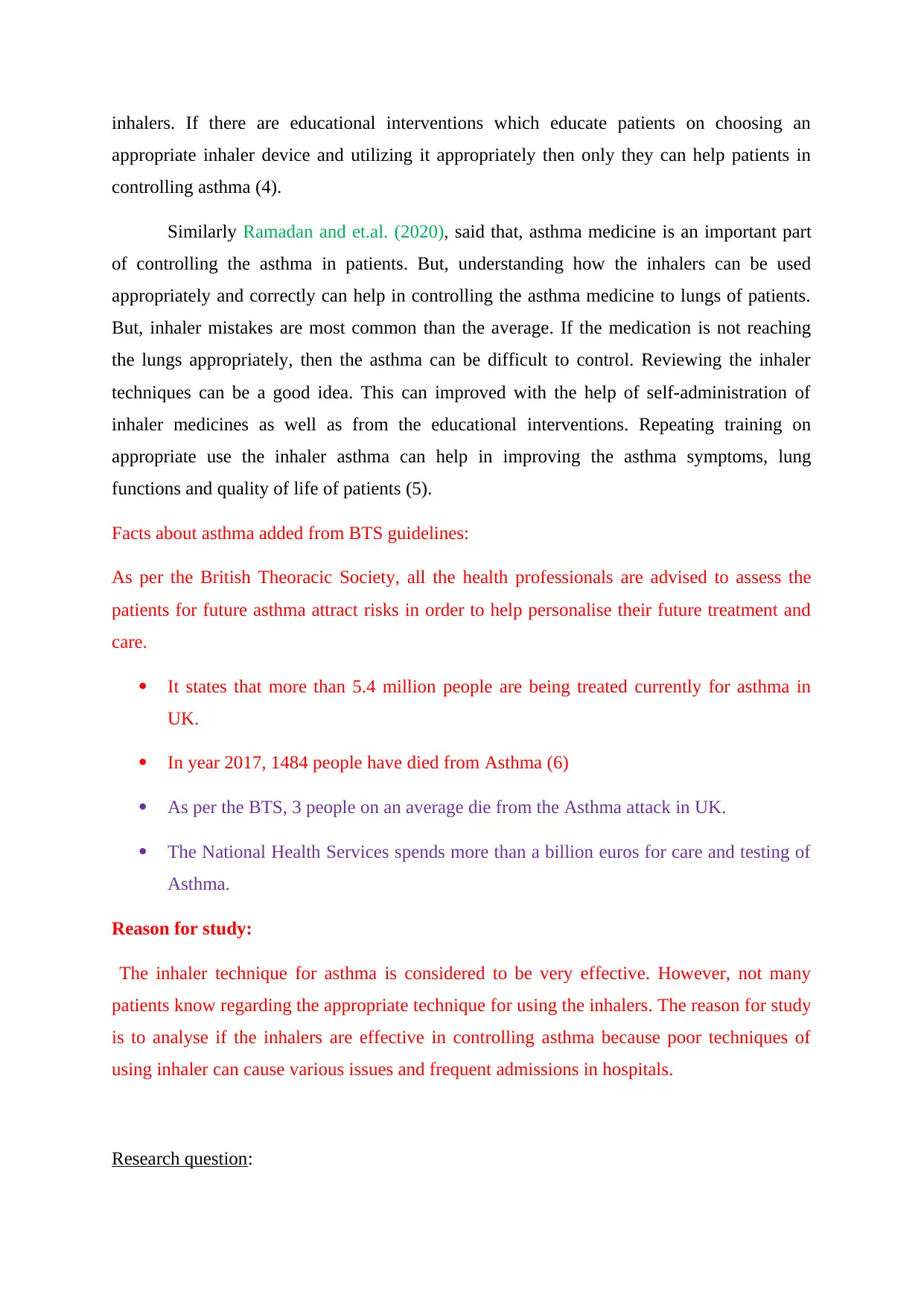
inhalers. If there are educational interventions which educate patients on choosing an
appropriate inhaler device and utilizing it appropriately then only they can help patients in
controlling asthma (4).
Similarly Ramadan and et.al. (2020), said that, asthma medicine is an important part
of controlling the asthma in patients. But, understanding how the inhalers can be used
appropriately and correctly can help in controlling the asthma medicine to lungs of patients.
But, inhaler mistakes are most common than the average. If the medication is not reaching
the lungs appropriately, then the asthma can be difficult to control. Reviewing the inhaler
techniques can be a good idea. This can improved with the help of self-administration of
inhaler medicines as well as from the educational interventions. Repeating training on
appropriate use the inhaler asthma can help in improving the asthma symptoms, lung
functions and quality of life of patients (5).
Facts about asthma added from BTS guidelines:
As per the British Theoracic Society, all the health professionals are advised to assess the
patients for future asthma attract risks in order to help personalise their future treatment and
care.
It states that more than 5.4 million people are being treated currently for asthma in
UK.
In year 2017, 1484 people have died from Asthma (6)
As per the BTS, 3 people on an average die from the Asthma attack in UK.
The National Health Services spends more than a billion euros for care and testing of
Asthma.
Reason for study:
The inhaler technique for asthma is considered to be very effective. However, not many
patients know regarding the appropriate technique for using the inhalers. The reason for study
is to analyse if the inhalers are effective in controlling asthma because poor techniques of
using inhaler can cause various issues and frequent admissions in hospitals.
Research question:
appropriate inhaler device and utilizing it appropriately then only they can help patients in
controlling asthma (4).
Similarly Ramadan and et.al. (2020), said that, asthma medicine is an important part
of controlling the asthma in patients. But, understanding how the inhalers can be used
appropriately and correctly can help in controlling the asthma medicine to lungs of patients.
But, inhaler mistakes are most common than the average. If the medication is not reaching
the lungs appropriately, then the asthma can be difficult to control. Reviewing the inhaler
techniques can be a good idea. This can improved with the help of self-administration of
inhaler medicines as well as from the educational interventions. Repeating training on
appropriate use the inhaler asthma can help in improving the asthma symptoms, lung
functions and quality of life of patients (5).
Facts about asthma added from BTS guidelines:
As per the British Theoracic Society, all the health professionals are advised to assess the
patients for future asthma attract risks in order to help personalise their future treatment and
care.
It states that more than 5.4 million people are being treated currently for asthma in
UK.
In year 2017, 1484 people have died from Asthma (6)
As per the BTS, 3 people on an average die from the Asthma attack in UK.
The National Health Services spends more than a billion euros for care and testing of
Asthma.
Reason for study:
The inhaler technique for asthma is considered to be very effective. However, not many
patients know regarding the appropriate technique for using the inhalers. The reason for study
is to analyse if the inhalers are effective in controlling asthma because poor techniques of
using inhaler can cause various issues and frequent admissions in hospitals.
Research question:
Secure Best Marks with AI Grader
Need help grading? Try our AI Grader for instant feedback on your assignments.
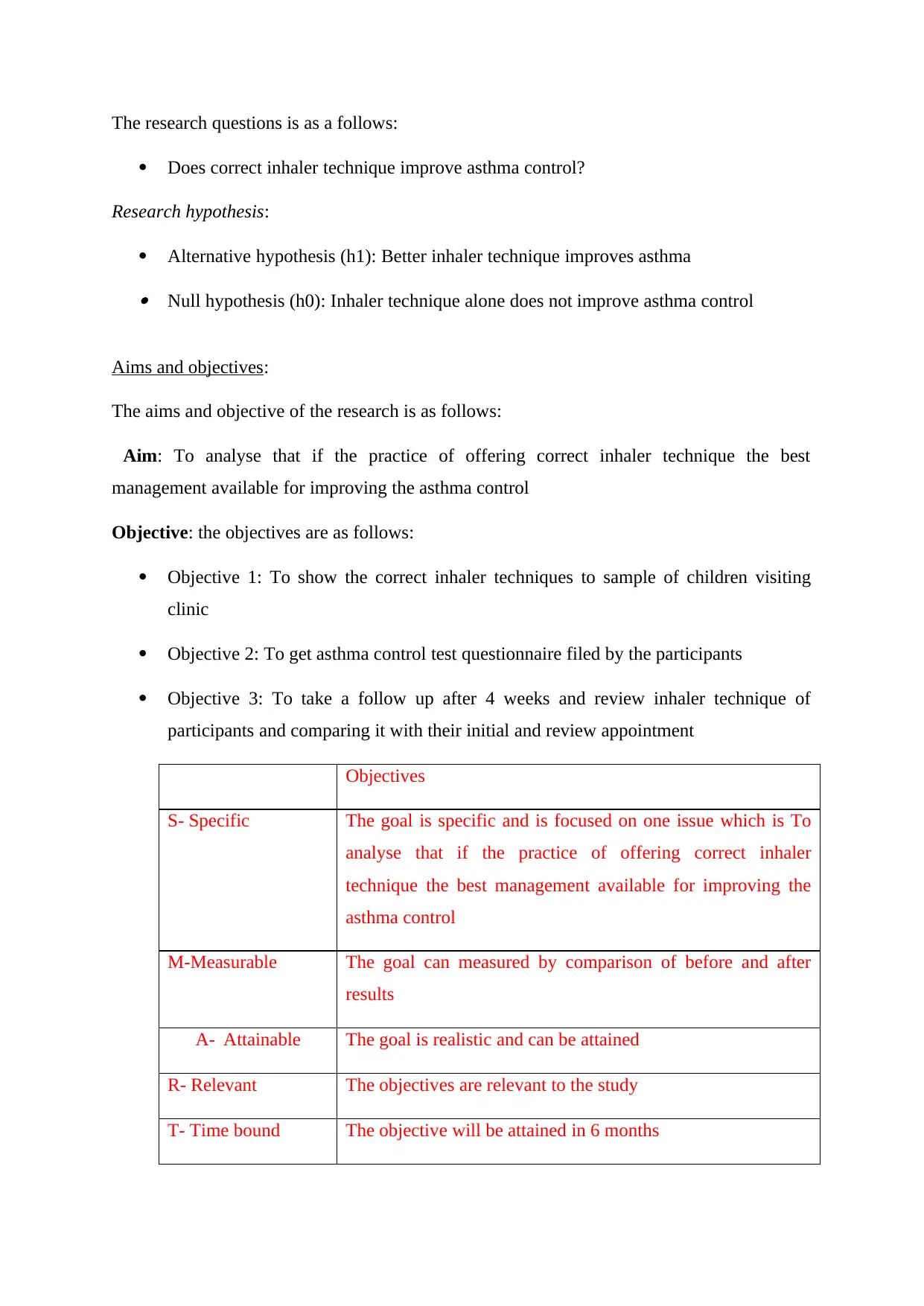
The research questions is as a follows:
Does correct inhaler technique improve asthma control?
Research hypothesis:
Alternative hypothesis (h1): Better inhaler technique improves asthma Null hypothesis (h0): Inhaler technique alone does not improve asthma control
Aims and objectives:
The aims and objective of the research is as follows:
Aim: To analyse that if the practice of offering correct inhaler technique the best
management available for improving the asthma control
Objective: the objectives are as follows:
Objective 1: To show the correct inhaler techniques to sample of children visiting
clinic
Objective 2: To get asthma control test questionnaire filed by the participants
Objective 3: To take a follow up after 4 weeks and review inhaler technique of
participants and comparing it with their initial and review appointment
Objectives
S- Specific The goal is specific and is focused on one issue which is To
analyse that if the practice of offering correct inhaler
technique the best management available for improving the
asthma control
M-Measurable The goal can measured by comparison of before and after
results
A- Attainable The goal is realistic and can be attained
R- Relevant The objectives are relevant to the study
T- Time bound The objective will be attained in 6 months
Does correct inhaler technique improve asthma control?
Research hypothesis:
Alternative hypothesis (h1): Better inhaler technique improves asthma Null hypothesis (h0): Inhaler technique alone does not improve asthma control
Aims and objectives:
The aims and objective of the research is as follows:
Aim: To analyse that if the practice of offering correct inhaler technique the best
management available for improving the asthma control
Objective: the objectives are as follows:
Objective 1: To show the correct inhaler techniques to sample of children visiting
clinic
Objective 2: To get asthma control test questionnaire filed by the participants
Objective 3: To take a follow up after 4 weeks and review inhaler technique of
participants and comparing it with their initial and review appointment
Objectives
S- Specific The goal is specific and is focused on one issue which is To
analyse that if the practice of offering correct inhaler
technique the best management available for improving the
asthma control
M-Measurable The goal can measured by comparison of before and after
results
A- Attainable The goal is realistic and can be attained
R- Relevant The objectives are relevant to the study
T- Time bound The objective will be attained in 6 months
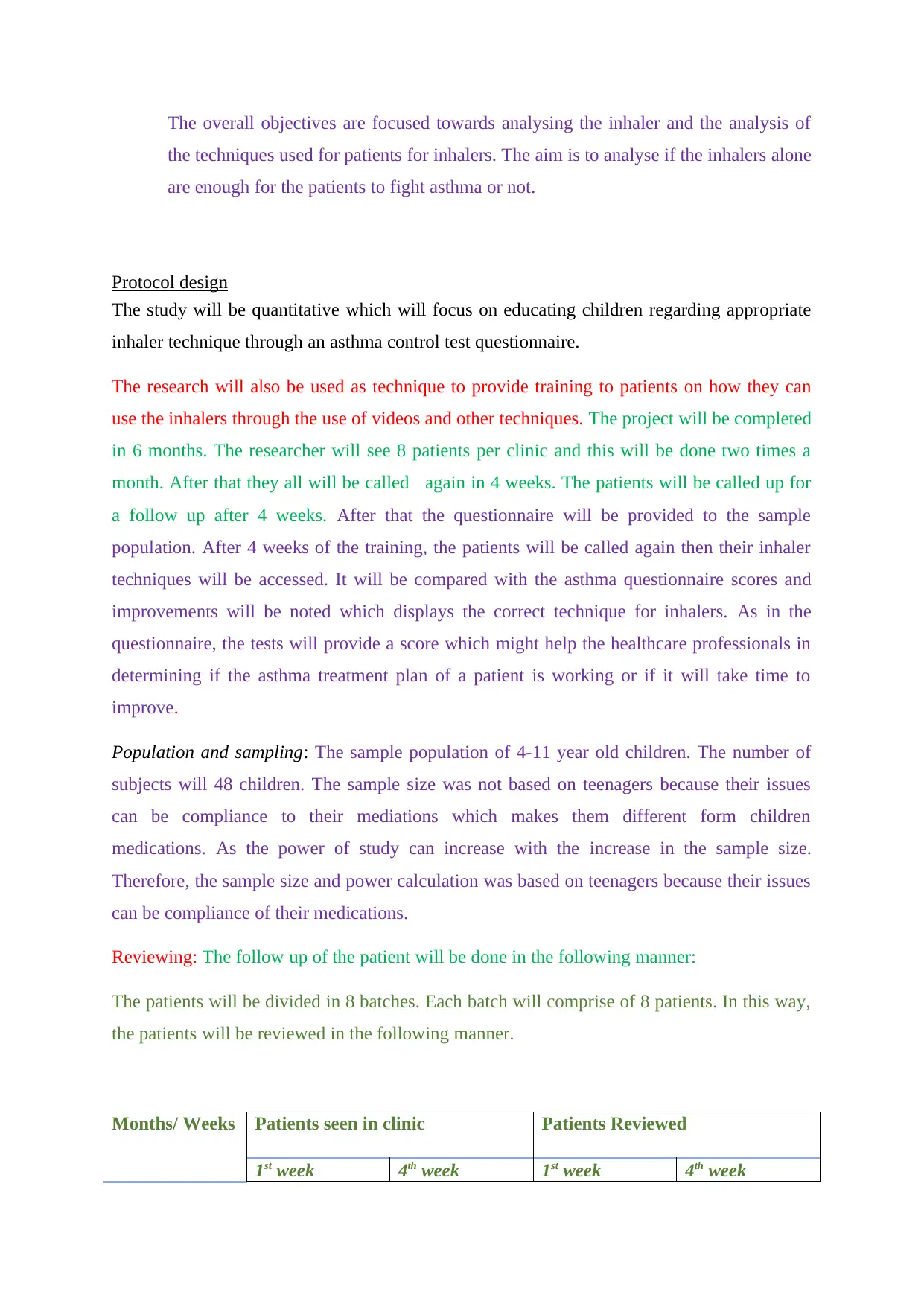
The overall objectives are focused towards analysing the inhaler and the analysis of
the techniques used for patients for inhalers. The aim is to analyse if the inhalers alone
are enough for the patients to fight asthma or not.
Protocol design
The study will be quantitative which will focus on educating children regarding appropriate
inhaler technique through an asthma control test questionnaire.
The research will also be used as technique to provide training to patients on how they can
use the inhalers through the use of videos and other techniques. The project will be completed
in 6 months. The researcher will see 8 patients per clinic and this will be done two times a
month. After that they all will be called again in 4 weeks. The patients will be called up for
a follow up after 4 weeks. After that the questionnaire will be provided to the sample
population. After 4 weeks of the training, the patients will be called again then their inhaler
techniques will be accessed. It will be compared with the asthma questionnaire scores and
improvements will be noted which displays the correct technique for inhalers. As in the
questionnaire, the tests will provide a score which might help the healthcare professionals in
determining if the asthma treatment plan of a patient is working or if it will take time to
improve.
Population and sampling: The sample population of 4-11 year old children. The number of
subjects will 48 children. The sample size was not based on teenagers because their issues
can be compliance to their mediations which makes them different form children
medications. As the power of study can increase with the increase in the sample size.
Therefore, the sample size and power calculation was based on teenagers because their issues
can be compliance of their medications.
Reviewing: The follow up of the patient will be done in the following manner:
The patients will be divided in 8 batches. Each batch will comprise of 8 patients. In this way,
the patients will be reviewed in the following manner.
Months/ Weeks Patients seen in clinic Patients Reviewed
1st week 4th week 1st week 4th week
the techniques used for patients for inhalers. The aim is to analyse if the inhalers alone
are enough for the patients to fight asthma or not.
Protocol design
The study will be quantitative which will focus on educating children regarding appropriate
inhaler technique through an asthma control test questionnaire.
The research will also be used as technique to provide training to patients on how they can
use the inhalers through the use of videos and other techniques. The project will be completed
in 6 months. The researcher will see 8 patients per clinic and this will be done two times a
month. After that they all will be called again in 4 weeks. The patients will be called up for
a follow up after 4 weeks. After that the questionnaire will be provided to the sample
population. After 4 weeks of the training, the patients will be called again then their inhaler
techniques will be accessed. It will be compared with the asthma questionnaire scores and
improvements will be noted which displays the correct technique for inhalers. As in the
questionnaire, the tests will provide a score which might help the healthcare professionals in
determining if the asthma treatment plan of a patient is working or if it will take time to
improve.
Population and sampling: The sample population of 4-11 year old children. The number of
subjects will 48 children. The sample size was not based on teenagers because their issues
can be compliance to their mediations which makes them different form children
medications. As the power of study can increase with the increase in the sample size.
Therefore, the sample size and power calculation was based on teenagers because their issues
can be compliance of their medications.
Reviewing: The follow up of the patient will be done in the following manner:
The patients will be divided in 8 batches. Each batch will comprise of 8 patients. In this way,
the patients will be reviewed in the following manner.
Months/ Weeks Patients seen in clinic Patients Reviewed
1st week 4th week 1st week 4th week
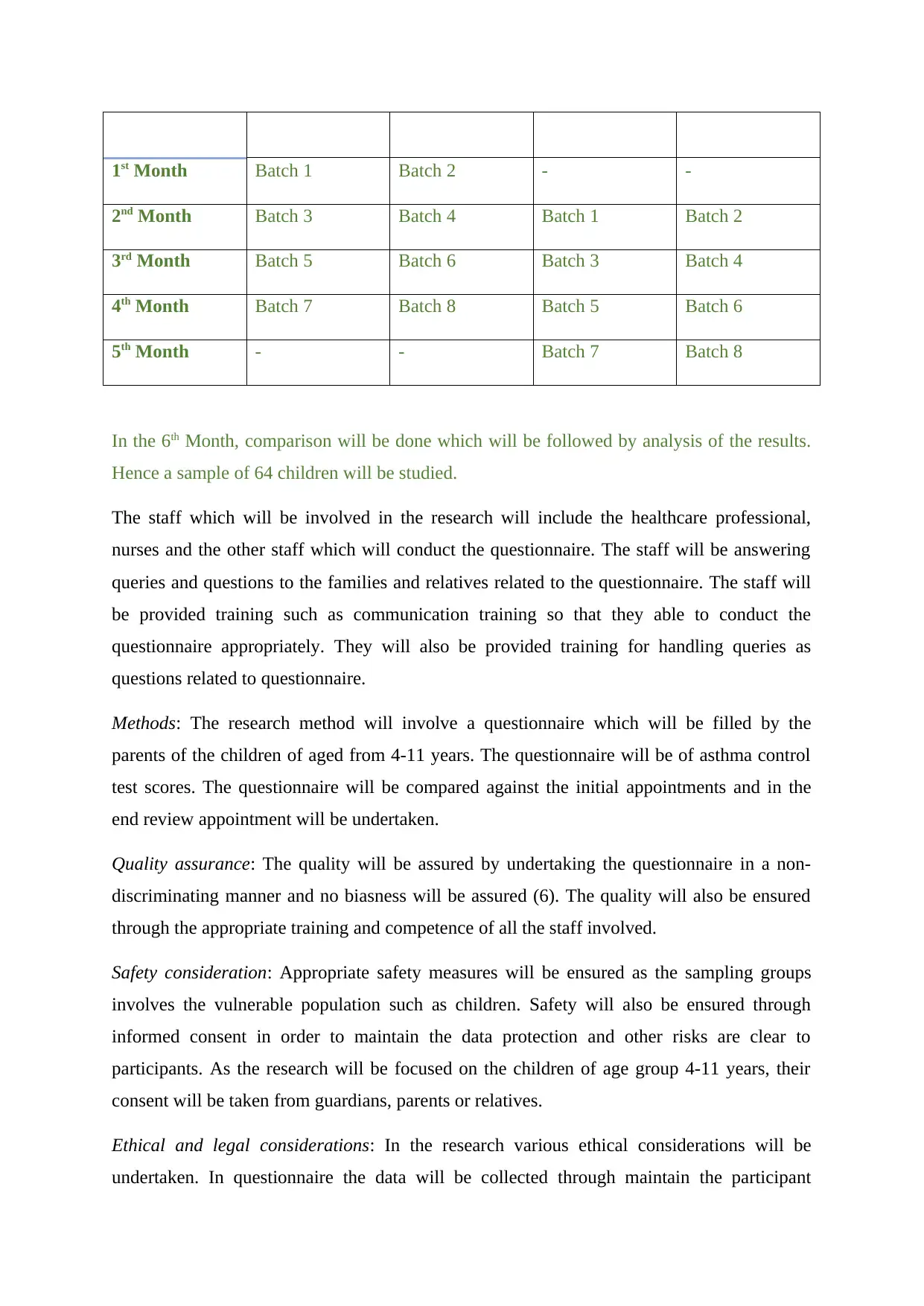
1st Month Batch 1 Batch 2 - -
2nd Month Batch 3 Batch 4 Batch 1 Batch 2
3rd Month Batch 5 Batch 6 Batch 3 Batch 4
4th Month Batch 7 Batch 8 Batch 5 Batch 6
5th Month - - Batch 7 Batch 8
In the 6th Month, comparison will be done which will be followed by analysis of the results.
Hence a sample of 64 children will be studied.
The staff which will be involved in the research will include the healthcare professional,
nurses and the other staff which will conduct the questionnaire. The staff will be answering
queries and questions to the families and relatives related to the questionnaire. The staff will
be provided training such as communication training so that they able to conduct the
questionnaire appropriately. They will also be provided training for handling queries as
questions related to questionnaire.
Methods: The research method will involve a questionnaire which will be filled by the
parents of the children of aged from 4-11 years. The questionnaire will be of asthma control
test scores. The questionnaire will be compared against the initial appointments and in the
end review appointment will be undertaken.
Quality assurance: The quality will be assured by undertaking the questionnaire in a non-
discriminating manner and no biasness will be assured (6). The quality will also be ensured
through the appropriate training and competence of all the staff involved.
Safety consideration: Appropriate safety measures will be ensured as the sampling groups
involves the vulnerable population such as children. Safety will also be ensured through
informed consent in order to maintain the data protection and other risks are clear to
participants. As the research will be focused on the children of age group 4-11 years, their
consent will be taken from guardians, parents or relatives.
Ethical and legal considerations: In the research various ethical considerations will be
undertaken. In questionnaire the data will be collected through maintain the participant
2nd Month Batch 3 Batch 4 Batch 1 Batch 2
3rd Month Batch 5 Batch 6 Batch 3 Batch 4
4th Month Batch 7 Batch 8 Batch 5 Batch 6
5th Month - - Batch 7 Batch 8
In the 6th Month, comparison will be done which will be followed by analysis of the results.
Hence a sample of 64 children will be studied.
The staff which will be involved in the research will include the healthcare professional,
nurses and the other staff which will conduct the questionnaire. The staff will be answering
queries and questions to the families and relatives related to the questionnaire. The staff will
be provided training such as communication training so that they able to conduct the
questionnaire appropriately. They will also be provided training for handling queries as
questions related to questionnaire.
Methods: The research method will involve a questionnaire which will be filled by the
parents of the children of aged from 4-11 years. The questionnaire will be of asthma control
test scores. The questionnaire will be compared against the initial appointments and in the
end review appointment will be undertaken.
Quality assurance: The quality will be assured by undertaking the questionnaire in a non-
discriminating manner and no biasness will be assured (6). The quality will also be ensured
through the appropriate training and competence of all the staff involved.
Safety consideration: Appropriate safety measures will be ensured as the sampling groups
involves the vulnerable population such as children. Safety will also be ensured through
informed consent in order to maintain the data protection and other risks are clear to
participants. As the research will be focused on the children of age group 4-11 years, their
consent will be taken from guardians, parents or relatives.
Ethical and legal considerations: In the research various ethical considerations will be
undertaken. In questionnaire the data will be collected through maintain the participant
Paraphrase This Document
Need a fresh take? Get an instant paraphrase of this document with our AI Paraphraser
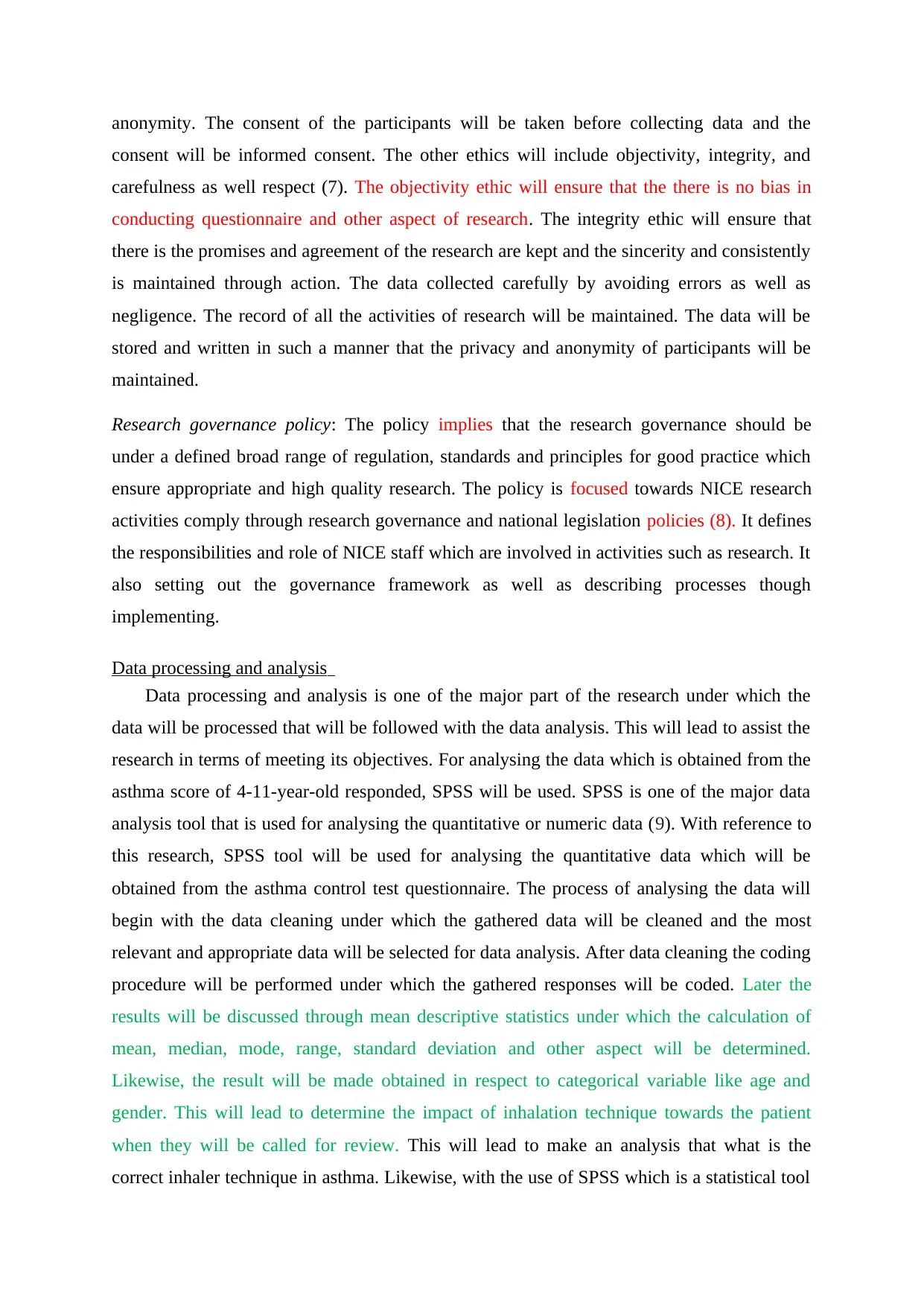
anonymity. The consent of the participants will be taken before collecting data and the
consent will be informed consent. The other ethics will include objectivity, integrity, and
carefulness as well respect (7). The objectivity ethic will ensure that the there is no bias in
conducting questionnaire and other aspect of research. The integrity ethic will ensure that
there is the promises and agreement of the research are kept and the sincerity and consistently
is maintained through action. The data collected carefully by avoiding errors as well as
negligence. The record of all the activities of research will be maintained. The data will be
stored and written in such a manner that the privacy and anonymity of participants will be
maintained.
Research governance policy: The policy implies that the research governance should be
under a defined broad range of regulation, standards and principles for good practice which
ensure appropriate and high quality research. The policy is focused towards NICE research
activities comply through research governance and national legislation policies (8). It defines
the responsibilities and role of NICE staff which are involved in activities such as research. It
also setting out the governance framework as well as describing processes though
implementing.
Data processing and analysis
Data processing and analysis is one of the major part of the research under which the
data will be processed that will be followed with the data analysis. This will lead to assist the
research in terms of meeting its objectives. For analysing the data which is obtained from the
asthma score of 4-11-year-old responded, SPSS will be used. SPSS is one of the major data
analysis tool that is used for analysing the quantitative or numeric data (9). With reference to
this research, SPSS tool will be used for analysing the quantitative data which will be
obtained from the asthma control test questionnaire. The process of analysing the data will
begin with the data cleaning under which the gathered data will be cleaned and the most
relevant and appropriate data will be selected for data analysis. After data cleaning the coding
procedure will be performed under which the gathered responses will be coded. Later the
results will be discussed through mean descriptive statistics under which the calculation of
mean, median, mode, range, standard deviation and other aspect will be determined.
Likewise, the result will be made obtained in respect to categorical variable like age and
gender. This will lead to determine the impact of inhalation technique towards the patient
when they will be called for review. This will lead to make an analysis that what is the
correct inhaler technique in asthma. Likewise, with the use of SPSS which is a statistical tool
consent will be informed consent. The other ethics will include objectivity, integrity, and
carefulness as well respect (7). The objectivity ethic will ensure that the there is no bias in
conducting questionnaire and other aspect of research. The integrity ethic will ensure that
there is the promises and agreement of the research are kept and the sincerity and consistently
is maintained through action. The data collected carefully by avoiding errors as well as
negligence. The record of all the activities of research will be maintained. The data will be
stored and written in such a manner that the privacy and anonymity of participants will be
maintained.
Research governance policy: The policy implies that the research governance should be
under a defined broad range of regulation, standards and principles for good practice which
ensure appropriate and high quality research. The policy is focused towards NICE research
activities comply through research governance and national legislation policies (8). It defines
the responsibilities and role of NICE staff which are involved in activities such as research. It
also setting out the governance framework as well as describing processes though
implementing.
Data processing and analysis
Data processing and analysis is one of the major part of the research under which the
data will be processed that will be followed with the data analysis. This will lead to assist the
research in terms of meeting its objectives. For analysing the data which is obtained from the
asthma score of 4-11-year-old responded, SPSS will be used. SPSS is one of the major data
analysis tool that is used for analysing the quantitative or numeric data (9). With reference to
this research, SPSS tool will be used for analysing the quantitative data which will be
obtained from the asthma control test questionnaire. The process of analysing the data will
begin with the data cleaning under which the gathered data will be cleaned and the most
relevant and appropriate data will be selected for data analysis. After data cleaning the coding
procedure will be performed under which the gathered responses will be coded. Later the
results will be discussed through mean descriptive statistics under which the calculation of
mean, median, mode, range, standard deviation and other aspect will be determined.
Likewise, the result will be made obtained in respect to categorical variable like age and
gender. This will lead to determine the impact of inhalation technique towards the patient
when they will be called for review. This will lead to make an analysis that what is the
correct inhaler technique in asthma. Likewise, with the use of SPSS which is a statistical tool
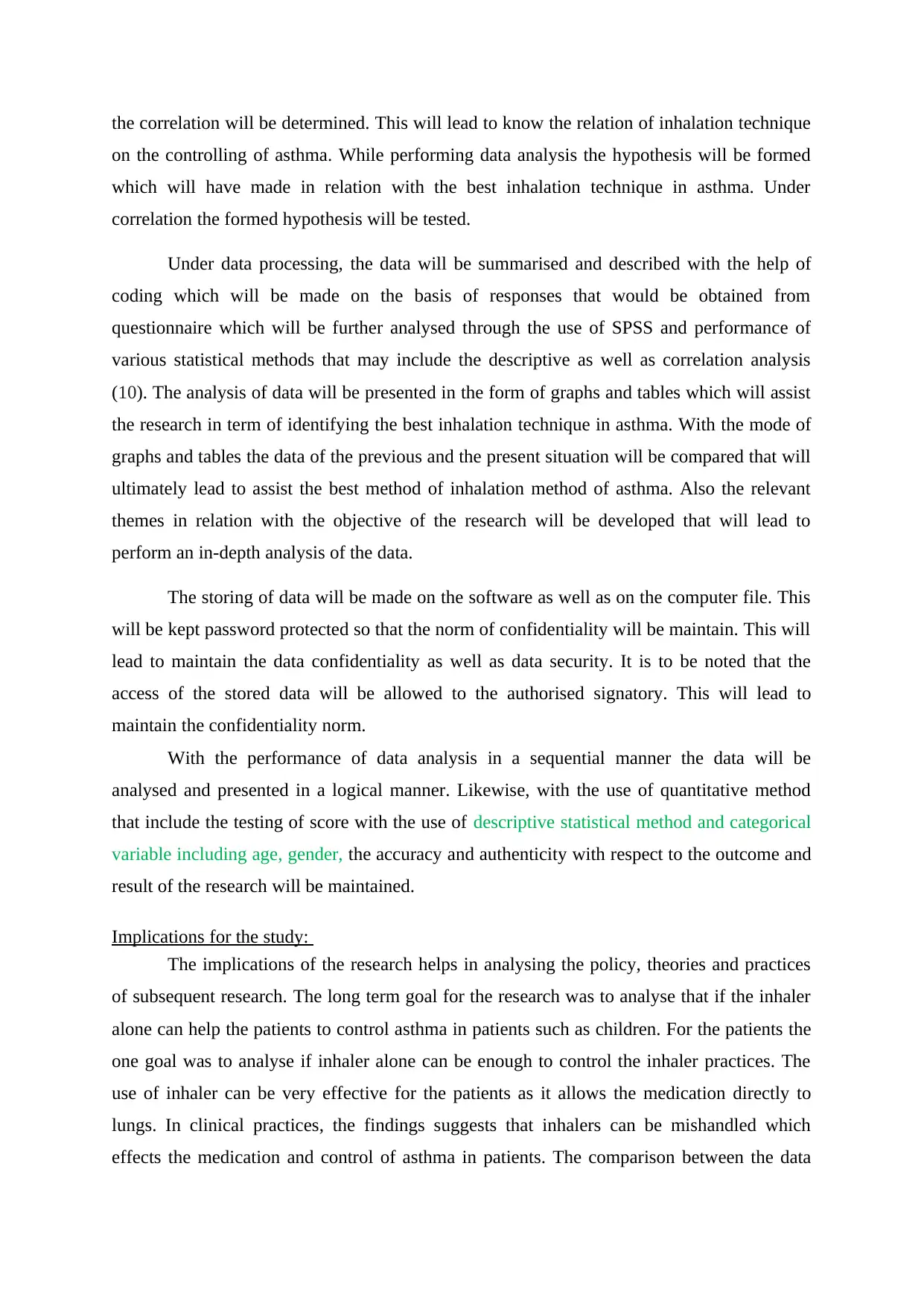
the correlation will be determined. This will lead to know the relation of inhalation technique
on the controlling of asthma. While performing data analysis the hypothesis will be formed
which will have made in relation with the best inhalation technique in asthma. Under
correlation the formed hypothesis will be tested.
Under data processing, the data will be summarised and described with the help of
coding which will be made on the basis of responses that would be obtained from
questionnaire which will be further analysed through the use of SPSS and performance of
various statistical methods that may include the descriptive as well as correlation analysis
(10). The analysis of data will be presented in the form of graphs and tables which will assist
the research in term of identifying the best inhalation technique in asthma. With the mode of
graphs and tables the data of the previous and the present situation will be compared that will
ultimately lead to assist the best method of inhalation method of asthma. Also the relevant
themes in relation with the objective of the research will be developed that will lead to
perform an in-depth analysis of the data.
The storing of data will be made on the software as well as on the computer file. This
will be kept password protected so that the norm of confidentiality will be maintain. This will
lead to maintain the data confidentiality as well as data security. It is to be noted that the
access of the stored data will be allowed to the authorised signatory. This will lead to
maintain the confidentiality norm.
With the performance of data analysis in a sequential manner the data will be
analysed and presented in a logical manner. Likewise, with the use of quantitative method
that include the testing of score with the use of descriptive statistical method and categorical
variable including age, gender, the accuracy and authenticity with respect to the outcome and
result of the research will be maintained.
Implications for the study:
The implications of the research helps in analysing the policy, theories and practices
of subsequent research. The long term goal for the research was to analyse that if the inhaler
alone can help the patients to control asthma in patients such as children. For the patients the
one goal was to analyse if inhaler alone can be enough to control the inhaler practices. The
use of inhaler can be very effective for the patients as it allows the medication directly to
lungs. In clinical practices, the findings suggests that inhalers can be mishandled which
effects the medication and control of asthma in patients. The comparison between the data
on the controlling of asthma. While performing data analysis the hypothesis will be formed
which will have made in relation with the best inhalation technique in asthma. Under
correlation the formed hypothesis will be tested.
Under data processing, the data will be summarised and described with the help of
coding which will be made on the basis of responses that would be obtained from
questionnaire which will be further analysed through the use of SPSS and performance of
various statistical methods that may include the descriptive as well as correlation analysis
(10). The analysis of data will be presented in the form of graphs and tables which will assist
the research in term of identifying the best inhalation technique in asthma. With the mode of
graphs and tables the data of the previous and the present situation will be compared that will
ultimately lead to assist the best method of inhalation method of asthma. Also the relevant
themes in relation with the objective of the research will be developed that will lead to
perform an in-depth analysis of the data.
The storing of data will be made on the software as well as on the computer file. This
will be kept password protected so that the norm of confidentiality will be maintain. This will
lead to maintain the data confidentiality as well as data security. It is to be noted that the
access of the stored data will be allowed to the authorised signatory. This will lead to
maintain the confidentiality norm.
With the performance of data analysis in a sequential manner the data will be
analysed and presented in a logical manner. Likewise, with the use of quantitative method
that include the testing of score with the use of descriptive statistical method and categorical
variable including age, gender, the accuracy and authenticity with respect to the outcome and
result of the research will be maintained.
Implications for the study:
The implications of the research helps in analysing the policy, theories and practices
of subsequent research. The long term goal for the research was to analyse that if the inhaler
alone can help the patients to control asthma in patients such as children. For the patients the
one goal was to analyse if inhaler alone can be enough to control the inhaler practices. The
use of inhaler can be very effective for the patients as it allows the medication directly to
lungs. In clinical practices, the findings suggests that inhalers can be mishandled which
effects the medication and control of asthma in patients. The comparison between the data
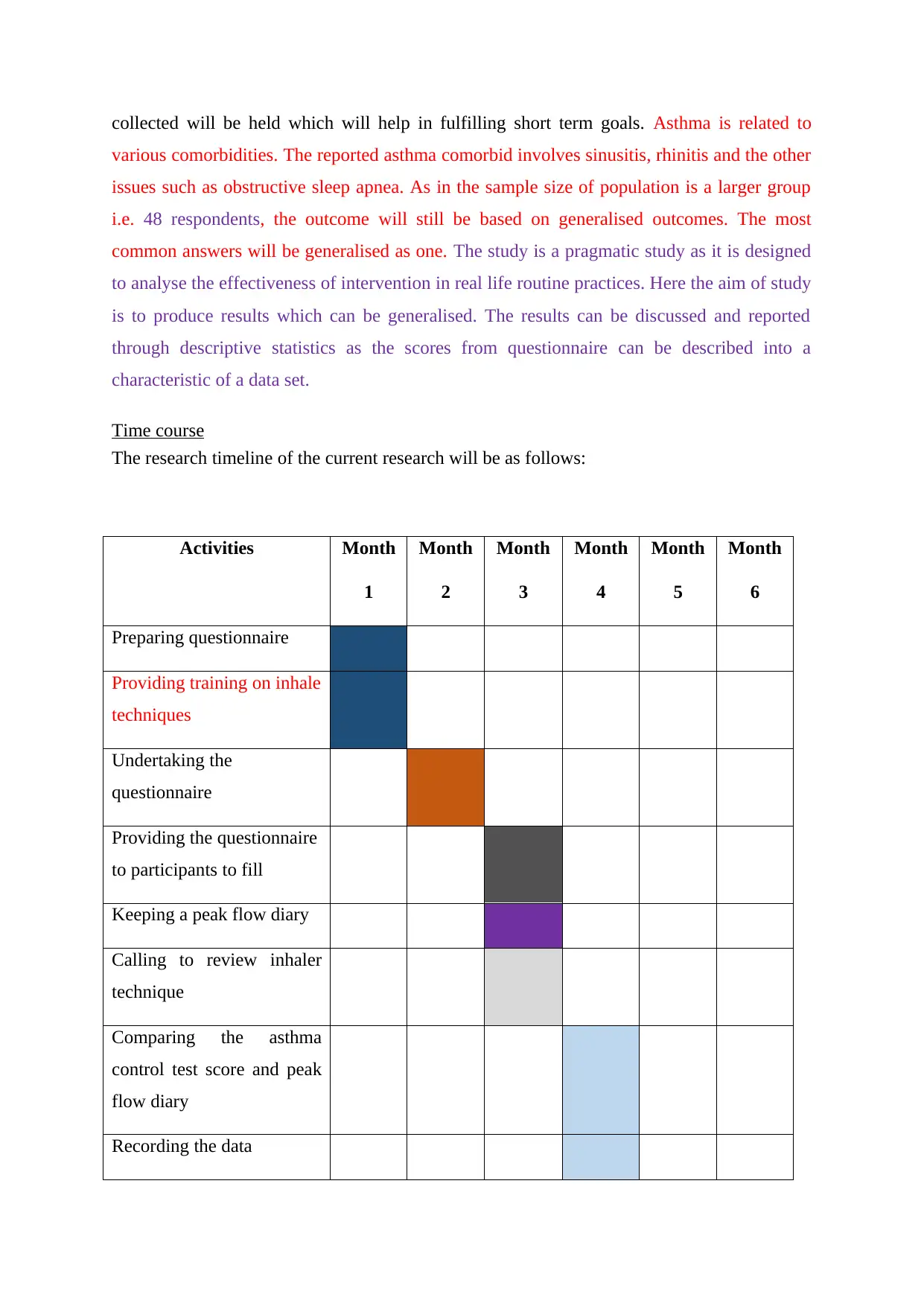
collected will be held which will help in fulfilling short term goals. Asthma is related to
various comorbidities. The reported asthma comorbid involves sinusitis, rhinitis and the other
issues such as obstructive sleep apnea. As in the sample size of population is a larger group
i.e. 48 respondents, the outcome will still be based on generalised outcomes. The most
common answers will be generalised as one. The study is a pragmatic study as it is designed
to analyse the effectiveness of intervention in real life routine practices. Here the aim of study
is to produce results which can be generalised. The results can be discussed and reported
through descriptive statistics as the scores from questionnaire can be described into a
characteristic of a data set.
Time course
The research timeline of the current research will be as follows:
Activities Month
1
Month
2
Month
3
Month
4
Month
5
Month
6
Preparing questionnaire
Providing training on inhale
techniques
Undertaking the
questionnaire
Providing the questionnaire
to participants to fill
Keeping a peak flow diary
Calling to review inhaler
technique
Comparing the asthma
control test score and peak
flow diary
Recording the data
various comorbidities. The reported asthma comorbid involves sinusitis, rhinitis and the other
issues such as obstructive sleep apnea. As in the sample size of population is a larger group
i.e. 48 respondents, the outcome will still be based on generalised outcomes. The most
common answers will be generalised as one. The study is a pragmatic study as it is designed
to analyse the effectiveness of intervention in real life routine practices. Here the aim of study
is to produce results which can be generalised. The results can be discussed and reported
through descriptive statistics as the scores from questionnaire can be described into a
characteristic of a data set.
Time course
The research timeline of the current research will be as follows:
Activities Month
1
Month
2
Month
3
Month
4
Month
5
Month
6
Preparing questionnaire
Providing training on inhale
techniques
Undertaking the
questionnaire
Providing the questionnaire
to participants to fill
Keeping a peak flow diary
Calling to review inhaler
technique
Comparing the asthma
control test score and peak
flow diary
Recording the data
Secure Best Marks with AI Grader
Need help grading? Try our AI Grader for instant feedback on your assignments.
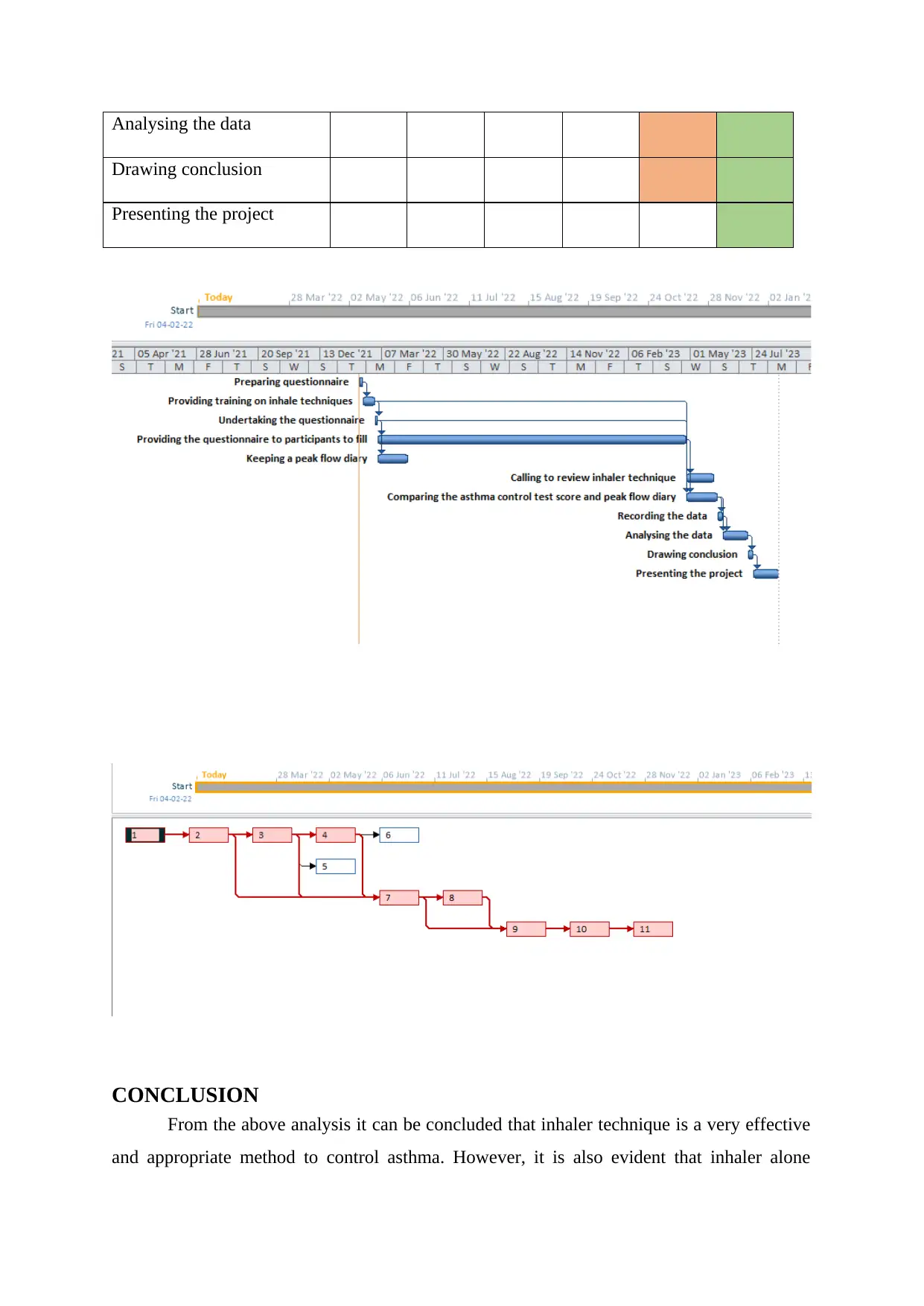
Analysing the data
Drawing conclusion
Presenting the project
CONCLUSION
From the above analysis it can be concluded that inhaler technique is a very effective
and appropriate method to control asthma. However, it is also evident that inhaler alone
Drawing conclusion
Presenting the project
CONCLUSION
From the above analysis it can be concluded that inhaler technique is a very effective
and appropriate method to control asthma. However, it is also evident that inhaler alone
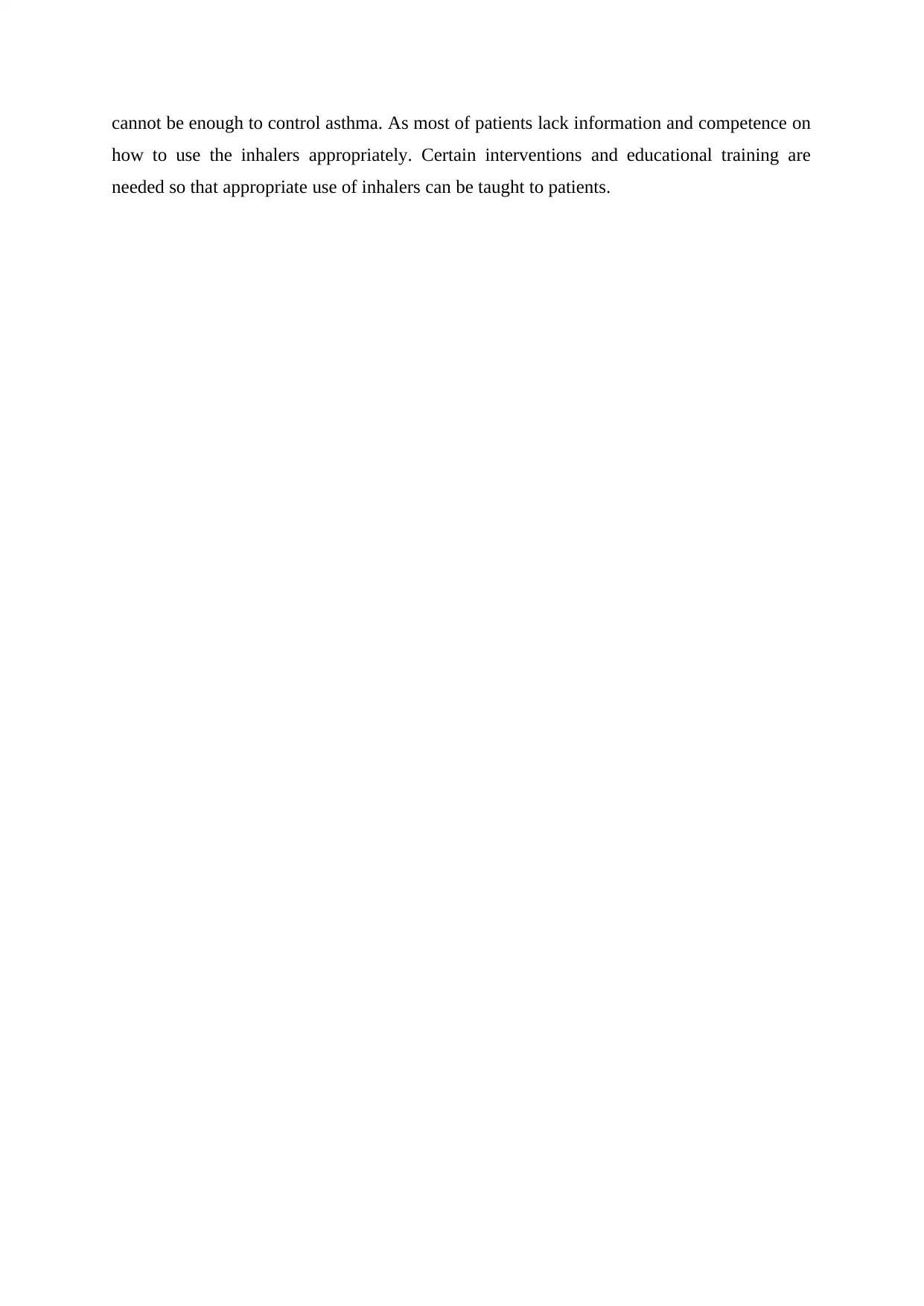
cannot be enough to control asthma. As most of patients lack information and competence on
how to use the inhalers appropriately. Certain interventions and educational training are
needed so that appropriate use of inhalers can be taught to patients.
how to use the inhalers appropriately. Certain interventions and educational training are
needed so that appropriate use of inhalers can be taught to patients.
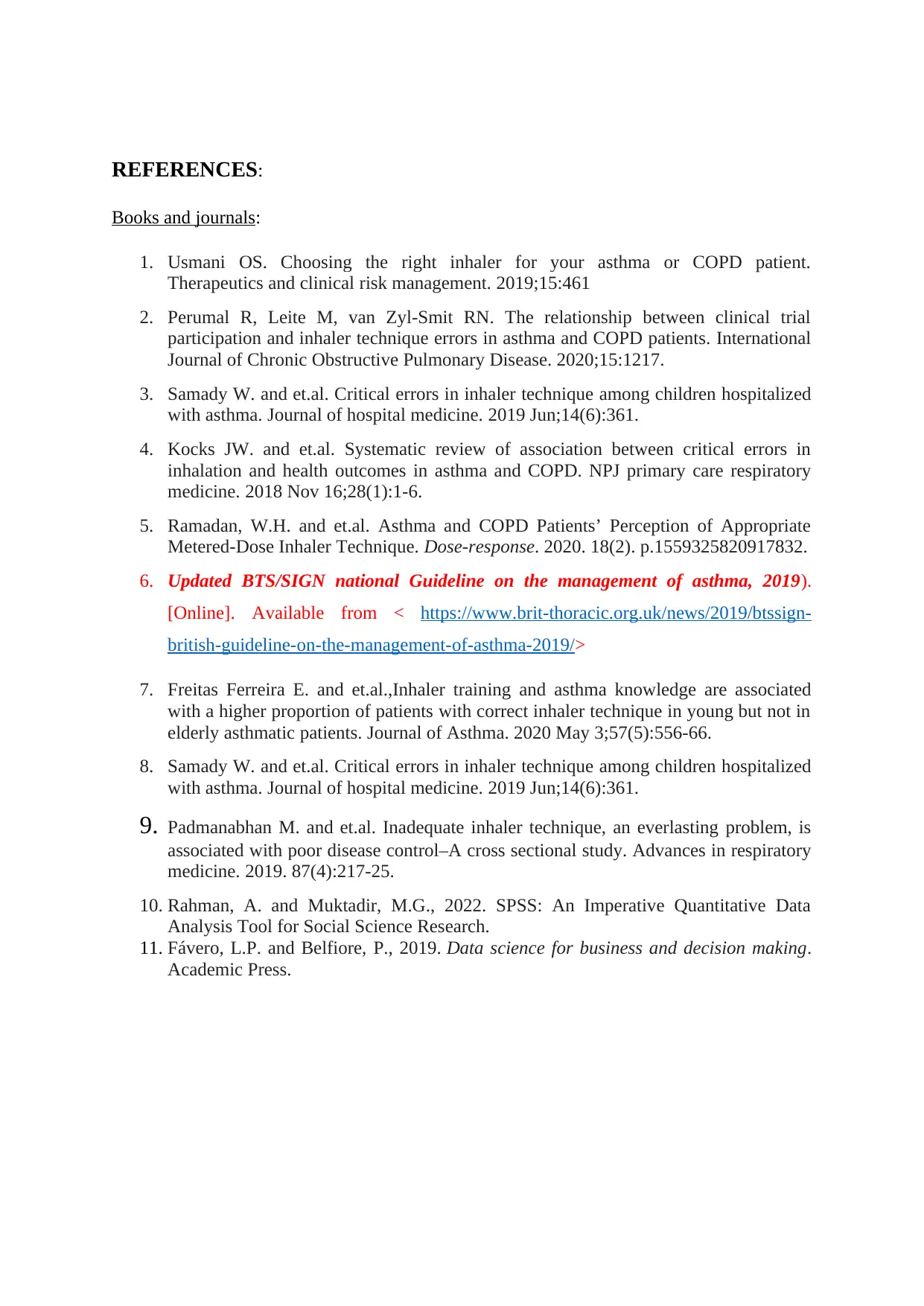
REFERENCES:
Books and journals:
1. Usmani OS. Choosing the right inhaler for your asthma or COPD patient.
Therapeutics and clinical risk management. 2019;15:461
2. Perumal R, Leite M, van Zyl-Smit RN. The relationship between clinical trial
participation and inhaler technique errors in asthma and COPD patients. International
Journal of Chronic Obstructive Pulmonary Disease. 2020;15:1217.
3. Samady W. and et.al. Critical errors in inhaler technique among children hospitalized
with asthma. Journal of hospital medicine. 2019 Jun;14(6):361.
4. Kocks JW. and et.al. Systematic review of association between critical errors in
inhalation and health outcomes in asthma and COPD. NPJ primary care respiratory
medicine. 2018 Nov 16;28(1):1-6.
5. Ramadan, W.H. and et.al. Asthma and COPD Patients’ Perception of Appropriate
Metered-Dose Inhaler Technique. Dose-response. 2020. 18(2). p.1559325820917832.
6. Updated BTS/SIGN national Guideline on the management of asthma, 2019).
[Online]. Available from < https://www.brit-thoracic.org.uk/news/2019/btssign-
british-guideline-on-the-management-of-asthma-2019/>
7. Freitas Ferreira E. and et.al.,Inhaler training and asthma knowledge are associated
with a higher proportion of patients with correct inhaler technique in young but not in
elderly asthmatic patients. Journal of Asthma. 2020 May 3;57(5):556-66.
8. Samady W. and et.al. Critical errors in inhaler technique among children hospitalized
with asthma. Journal of hospital medicine. 2019 Jun;14(6):361.
9. Padmanabhan M. and et.al. Inadequate inhaler technique, an everlasting problem, is
associated with poor disease control–A cross sectional study. Advances in respiratory
medicine. 2019. 87(4):217-25.
10. Rahman, A. and Muktadir, M.G., 2022. SPSS: An Imperative Quantitative Data
Analysis Tool for Social Science Research.
11. Fávero, L.P. and Belfiore, P., 2019. Data science for business and decision making.
Academic Press.
Books and journals:
1. Usmani OS. Choosing the right inhaler for your asthma or COPD patient.
Therapeutics and clinical risk management. 2019;15:461
2. Perumal R, Leite M, van Zyl-Smit RN. The relationship between clinical trial
participation and inhaler technique errors in asthma and COPD patients. International
Journal of Chronic Obstructive Pulmonary Disease. 2020;15:1217.
3. Samady W. and et.al. Critical errors in inhaler technique among children hospitalized
with asthma. Journal of hospital medicine. 2019 Jun;14(6):361.
4. Kocks JW. and et.al. Systematic review of association between critical errors in
inhalation and health outcomes in asthma and COPD. NPJ primary care respiratory
medicine. 2018 Nov 16;28(1):1-6.
5. Ramadan, W.H. and et.al. Asthma and COPD Patients’ Perception of Appropriate
Metered-Dose Inhaler Technique. Dose-response. 2020. 18(2). p.1559325820917832.
6. Updated BTS/SIGN national Guideline on the management of asthma, 2019).
[Online]. Available from < https://www.brit-thoracic.org.uk/news/2019/btssign-
british-guideline-on-the-management-of-asthma-2019/>
7. Freitas Ferreira E. and et.al.,Inhaler training and asthma knowledge are associated
with a higher proportion of patients with correct inhaler technique in young but not in
elderly asthmatic patients. Journal of Asthma. 2020 May 3;57(5):556-66.
8. Samady W. and et.al. Critical errors in inhaler technique among children hospitalized
with asthma. Journal of hospital medicine. 2019 Jun;14(6):361.
9. Padmanabhan M. and et.al. Inadequate inhaler technique, an everlasting problem, is
associated with poor disease control–A cross sectional study. Advances in respiratory
medicine. 2019. 87(4):217-25.
10. Rahman, A. and Muktadir, M.G., 2022. SPSS: An Imperative Quantitative Data
Analysis Tool for Social Science Research.
11. Fávero, L.P. and Belfiore, P., 2019. Data science for business and decision making.
Academic Press.
Paraphrase This Document
Need a fresh take? Get an instant paraphrase of this document with our AI Paraphraser

1 out of 14
Related Documents
Your All-in-One AI-Powered Toolkit for Academic Success.
+13062052269
info@desklib.com
Available 24*7 on WhatsApp / Email
![[object Object]](/_next/static/media/star-bottom.7253800d.svg)
Unlock your academic potential
© 2024 | Zucol Services PVT LTD | All rights reserved.





